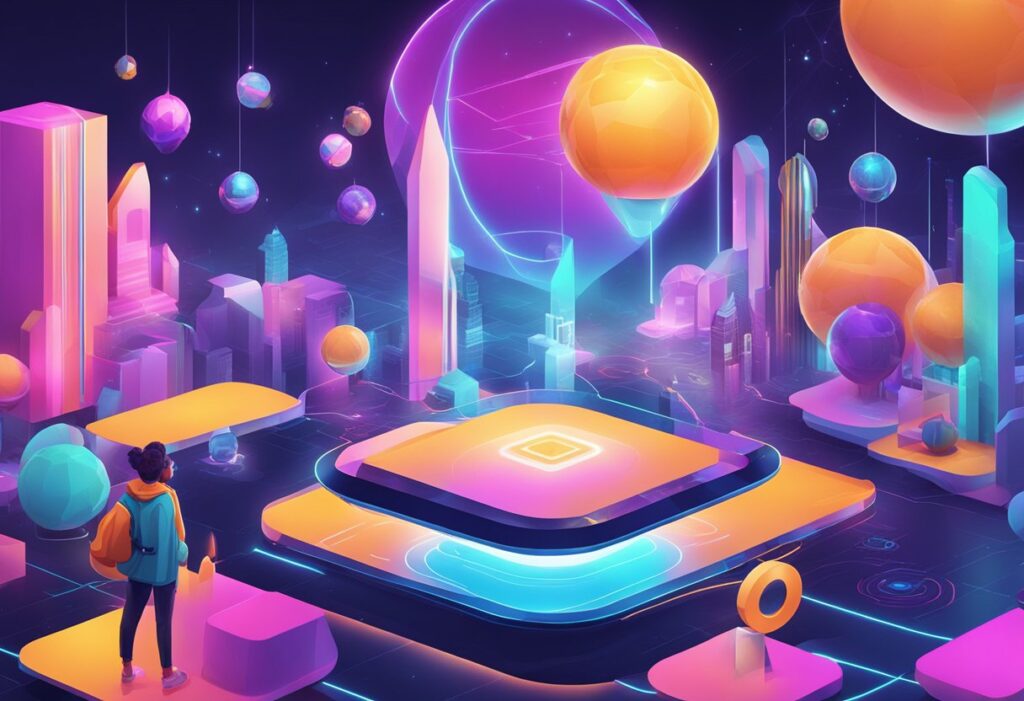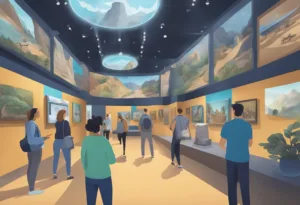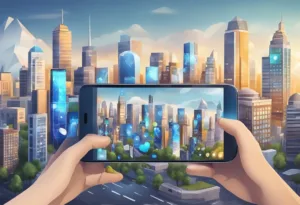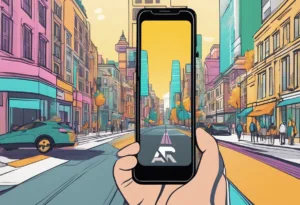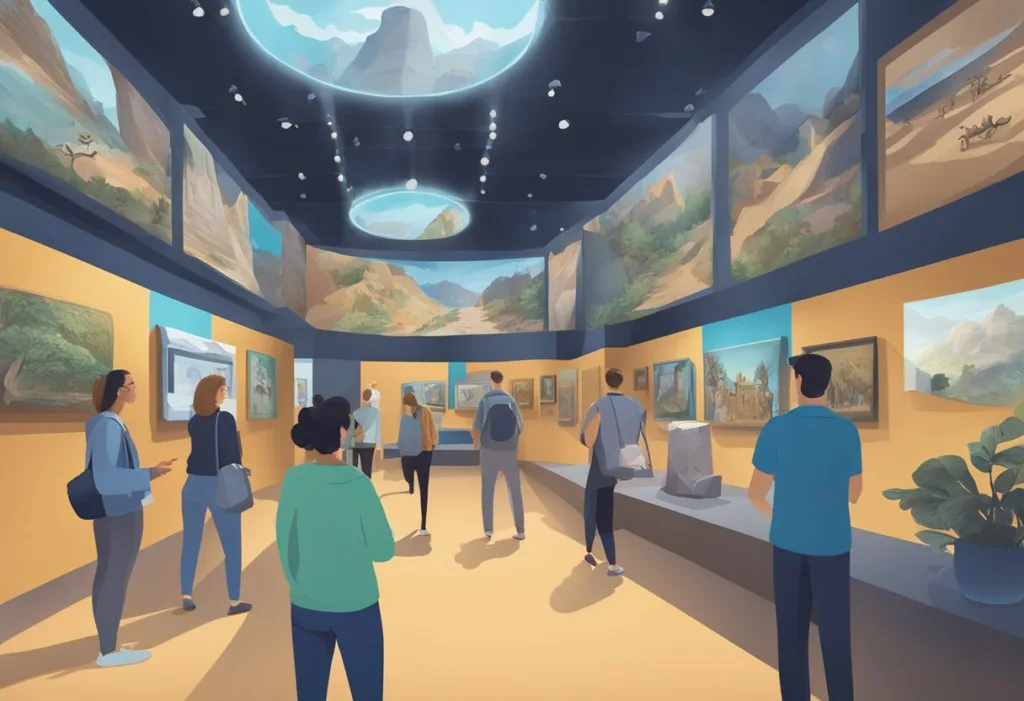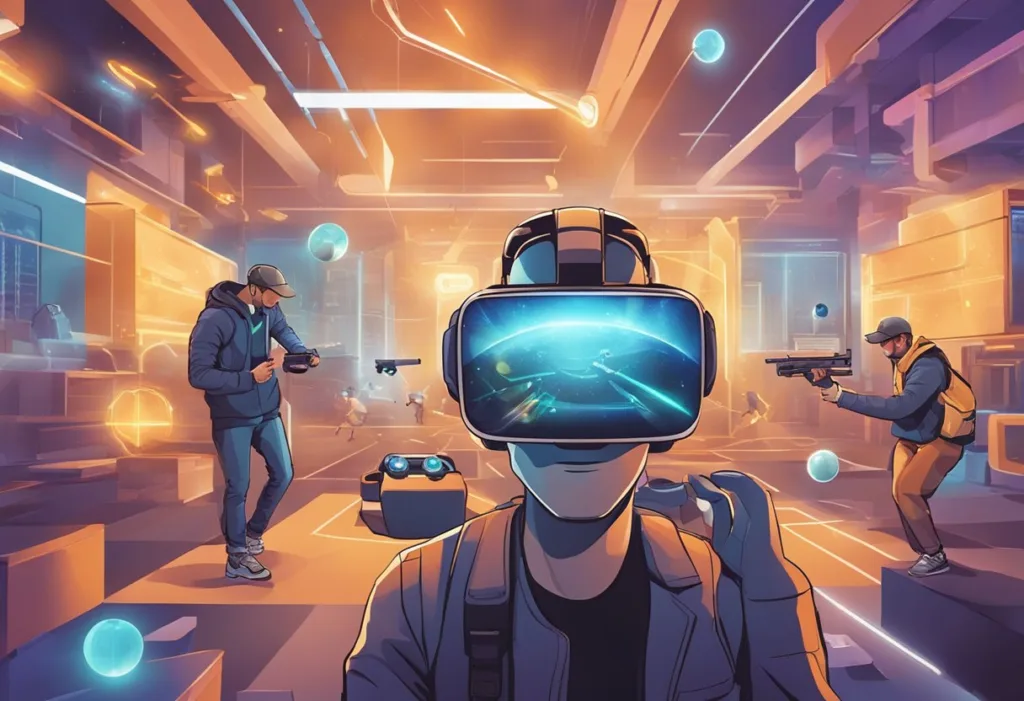The concept of the metaverse has been gaining momentum in recent years, with many companies and individuals investing in various projects. A metaverse is a virtual world that allows users to interact with each other and the environment through avatars. These virtual worlds are becoming increasingly popular, with many people seeing them as the future of entertainment, social media, and even work. In this blog post, I will share with you the top 15 best metaverse projects to explore in 2024 and what they are working on.
There are many metaverse projects currently available, each with its own unique features and benefits. The best metaverse projects offer immersive environments, engaging gameplay, and a sense of community. Some of the most popular metaverse projects include Decentraland, The Sandbox, Somnium Space, Axie Infinity, Gala, Enjin Coin, Metahero, Star Atlas, Bloktopia, and High Street. These projects offer a range of experiences, from virtual real estate to gaming and socializing.
Investing in a metaverse project can be an exciting opportunity for those looking to explore new forms of entertainment and social interaction. However, it is important to do your research and understand the risks involved. By choosing one of the best metaverse projects, you can ensure that you are investing in a high-quality experience that will provide hours of entertainment and engagement.
Understanding the Metaverse
The Metaverse is a term that refers to a shared, persistent, and immersive digital world where people can interact with each other in real-time. The Metaverse is a concept that has been around for a while, but it has gained more attention in recent years because of the advancements in virtual reality and blockchain technology.
Best metaverse projects
Here is a list of top metaverse projects:
- Decentraland (MANA)
- The Sandbox (SAND)
- Axie Infinity (AXS)
- Gala (GALA)
- Enjin Coin (ENJ)
- Metahero (HERO)
- Somnium Space (CUBE)
- Star Atlas (ATLAS)
- ApeCoin (APE)
- Internet Computer (ICP)
- Stacks (STX)
- Theta Network (THETA)
- Sensorium Galaxy (SENSO)
- Meme Kombat (MK)
- Floki (FLOKI)
Decentraland (MANA)
Decentraland is a virtual reality platform powered by the Ethereum blockchain that allows users to create, experience, and monetize content and applications. In this virtual world, users purchase plots of land that they can later navigate, build upon, and monetize. Decentraland offers a decentralized autonomous organization (DAO), where landowners can vote on the policies that determine how the world behaves.
The Sandbox (SAND)
The Sandbox is a community-driven platform where creators can monetize voxel assets and gaming experiences on the blockchain. The Sandbox leverages the powers of decentralized finance (DeFi) and non-fungible tokens (NFTs) to empower creators and offer a collaborative and interactive world. Users can create digital assets, build experiences, and earn rewards.
Axie Infinity (AXS)
Axie Infinity is a blockchain-based trading and battling game that is partially owned and operated by its players. Inspired by popular games like Pokémon, the game allows players to collect, breed, raise, battle, and trade token-based creatures known as Axies. These Axies can be turned into NFTs and sold on the Ethereum blockchain.
Gala (GALA)
Gala Games aims to take the gaming industry in a different direction by giving players back control over their games. Gala Games’ mission is to make “blockchain games you’ll actually want to play.” The project invites players to own their in-game items and influence the governance of the games within the Gala Games ecosystem.
Enjin Coin (ENJ)
Enjin Coin is a project that provides an ecosystem of interconnected, blockchain-based gaming products. Enjin’s flagship offering is the Enjin Network, a social gaming platform through which users can create websites and clans, chat, and host virtual item stores.
Metahero (HERO)
Metahero is a metaverse project that aims to create detailed digital versions of real-world objects, including people, that can be used across games, VR, social media, and online fashion. The project uses 3D scanning and modeling technology to create hyper-realistic avatars and virtual items that can be deployed in various digital landscapes.
Somnium Space (CUBE)
Somnium Space is a virtual reality space where users can buy land, build or import objects, games, and applications, and monetize their experiences. The platform offers a full-fledged VR economy, immersive social experiences, and the ability to integrate with other blockchains.
Star Atlas (ATLAS)
Star Atlas is a grand strategy game of space exploration, territorial conquest, and political domination. Built on the Solana blockchain, Star Atlas features a unique dual-token system that enables both governance and in-game transactions. Players can engage in deep space exploration, control resources, and participate in combat.
ApeCoin (APE)
ApeCoin is a token associated with the Bored Ape Yacht Club (BAYC) NFT project. ApeCoin serves as a utility token that allows token holders to participate in the APE ecosystem, which includes new games and services in the metaverse.
Internet Computer (ICP)
Internet Computer aims to extend the public internet so it can also be the world’s computing platform, thereby enabling the metaverse to be hosted on the internet itself. Internet Computer (ICP) is a layer-1 protocol developed by the DFINITY Foundation that seeks to create a decentralized internet.
Stacks (STX)
Stacks is a layer-1 blockchain solution designed to bring smart contracts and decentralized applications (DApps) to Bitcoin (BTC). Stacks enables developers to build apps and smart contracts that inherit all of Bitcoin’s powers but with more scalability and functionality.
Theta Network (THETA)
Theta Network is a blockchain-based network purpose-built for video streaming. Theta Network aims to decentralize video streaming, data delivery, and edge computing, making it more efficient, cost-effective, and fair for industry participants.
Sensorium Galaxy (SENSO)
Sensorium Galaxy is a digital metaverse that offers various VR experiences, including concerts, dance performances, and deep-sea adventures. Sensorium Galaxy aims to revolutionize the virtual space by providing high-quality virtual entertainment.
Meme Kombat (MK)
Meme Kombat is a unique metaverse project that focuses on the gamification of memes. The Meme Kombat Metaverse uses the $MK token to fuel its ecosystem, which is currently available to investors and players.
Floki (FLOKI)
Floki is a metaverse project that combines memes with utility and charitability. Floki aims to bring blockchain technology to the masses in a friendly and approachable manner, with a focus on creating an ecosystem that includes games and educational platforms.
The Rise of Virtual Worlds
Virtual worlds have been around for decades, but they have become more popular in recent years because of the advancements in technology. Virtual reality (VR) and augmented reality (AR) have made it possible for people to immerse themselves in virtual worlds and interact with other people in real-time.
The rise of virtual worlds has led to the creation of the Metaverse, which is a persistent and immersive digital world where people can interact with each other.
Blockchain Technology and NFTs
Blockchain technology has played a significant role in the development of the Metaverse. Blockchain technology is a decentralized ledger that allows for secure and transparent transactions. The Metaverse uses blockchain technology to create a decentralized autonomous organization (DAO) that governs the virtual world. The DAO is responsible for creating and enforcing rules and regulations within the Metaverse.
Non-fungible tokens (NFTs) are also a significant part of the Metaverse. NFTs are unique digital assets that are stored on the blockchain. NFTs can be used to represent virtual assets within the Metaverse, such as virtual real estate, virtual clothing, and virtual art. NFTs allow for ownership of virtual assets within the Metaverse, which gives users more control over their virtual lives.
The Metaverse is a persistent and immersive digital world that is created using blockchain technology and virtual reality. The rise of virtual worlds and the advancements in blockchain technology have made it possible for the Metaverse to become a reality.
The Metaverse is still in its early stages of development, but it has the potential to revolutionize the way people interact with each other in the digital world.
Leading Metaverse Platforms
The metaverse is a virtual world that has become a reality with the help of blockchain technology. It offers a unique opportunity for users to interact with each other in a virtual world. However, it is important to note that not all metaverse platforms are created equal. In this section, we will discuss some of the leading metaverse platforms that have gained popularity in recent years.
Decentraland and The Sandbox
Decentraland and The Sandbox are two of the most popular metaverse platforms that offer users a unique experience. Decentraland is a decentralized virtual world that allows users to create, experience, and monetize content and applications. It operates on the Ethereum blockchain and uses non-fungible tokens (NFTs) to represent virtual land and assets.
On the other hand, The Sandbox is a community-driven metaverse platform that allows users to create, share, and monetize their own gaming experiences. It uses blockchain technology and NFTs to represent virtual land and assets, allowing users to buy, sell, and trade them on the open market.
Gaming Giants Entering the Metaverse
Gaming giants such as Roblox and Fortnite have also entered the metaverse space, offering users a unique gaming experience.
Roblox is a popular gaming platform that allows users to create their own games and share them with others. It has since expanded to include a virtual economy where users can buy and sell virtual items using Robux, the platform’s virtual currency.
Fortnite, on the other hand, is a popular battle royale game that has expanded to include a metaverse experience. It offers users the ability to explore a virtual world, attend virtual concerts, and participate in other virtual events.
NFT Marketplaces
NFT marketplaces such as OpenSea have also become popular in recent years, offering users the ability to buy, sell, and trade NFTs representing virtual land and assets. These marketplaces have become an important part of the metaverse ecosystem, allowing users to monetize their virtual assets and participate in the virtual economy.
Horizon Worlds
Horizon Worlds is a metaverse platform that allows users to create and experience virtual worlds. It offers a unique experience that combines gaming, socializing, and creativity. It uses blockchain technology to enable users to buy, sell, and trade virtual land and assets.
The metaverse is a rapidly evolving space that offers a unique opportunity for users to interact with each other in a virtual world. The platforms discussed in this section are some of the leading metaverse platforms that have gained popularity in recent years. Each platform offers a unique experience, and users should explore them to find the one that best suits their needs.
Economic Models in the Metaverse
The metaverse is a virtual world that allows users to interact with each other in a simulated environment. It has the potential to revolutionize the way we work, play, and interact with each other. One of the most exciting aspects of the metaverse is its economic potential. In this section, we will explore some of the economic models that are emerging in the metaverse.
Monetization through Play-to-Earn
Play-to-earn is a new model of monetization that is emerging in the metaverse. In this model, users can earn cryptocurrency by playing games or participating in other activities within the virtual world.
This creates a new revenue stream for game developers and allows users to monetize their time spent in the metaverse. Cryptocurrencies like Ethereum and Axie Infinity’s AXS are being used for play-to-earn models.
Virtual Real Estate and Land Ownership
Virtual real estate and land ownership is another emerging economic model in the metaverse. Users can purchase plots of land in the virtual world and then develop them into virtual businesses or other virtual properties.
This creates a new market for virtual real estate and allows users to monetize their investment in the metaverse. Decentraland and Somnium Space are examples of virtual worlds with virtual real estate and land ownership models.
The economic potential of the metaverse is vast. Investors are pouring money into metaverse projects, and decentralized finance (DeFi) is being used to create new economic models. DAOs are being used to govern virtual worlds and create new revenue streams for users. The metaverse has the potential to revolutionize the way we think about work, play, and economics.
Metaverse Projects and Collaborations
Brands and NFT Partnerships
Many brands are exploring the potential of the metaverse and partnering with NFT projects to create unique experiences and products. Adidas, for example, has collaborated with the Bored Ape Yacht Club to release a limited edition set of NFTs inspired by the club’s iconic apes. Similarly, Gucci has partnered with Yuga Labs to release a collection of NFTs that represent the brand’s vision of the metaverse.
These collaborations not only allow brands to tap into the growing interest in NFTs and the metaverse, but also provide a new way for them to connect with their audience. By creating unique and exclusive products that can only be accessed through the metaverse, brands can offer a new level of engagement and exclusivity to their customers.
Community-Driven Projects
One of the most exciting aspects of the metaverse is the potential for community-driven projects. DAOs, or decentralized autonomous organizations, are a prime example of this. These organizations are run by a community of members who collectively make decisions and govern the project.
Many metaverse NFT projects are also community-driven, with members working together to create and develop the project. This not only creates a sense of ownership and investment in the project, but also allows for a more diverse and innovative range of ideas and perspectives.
The metaverse presents a unique opportunity for brands and communities to come together and create something truly special. By embracing the potential of NFTs and the metaverse, we can create a new digital world that is both exciting and inclusive.
Future Trends and Developments
Advancements in AR and VR Technology
As technology continues to advance, the possibilities for the metaverse are endless. One of the most significant advancements in recent years has been in the field of Augmented Reality (AR) and Virtual Reality (VR) technology. AR and VR headsets are becoming more affordable and accessible, making it easier for users to immerse themselves in the metaverse.
With the introduction of NVIDIA Omniverse and Unreal Engine 5, the metaverse is poised to become even more realistic and immersive. These technologies allow developers to create highly detailed and realistic environments, making the experience of being in the metaverse even more lifelike.
The Role of DAOs in Governance
Decentralized Autonomous Organizations (DAOs) are also expected to play a significant role in the future of the metaverse. DAOs are organizations that are run by code and operate on a decentralized blockchain network. They allow for decentralized decision-making and governance, making them ideal for managing the metaverse.
DAOs can be used to manage virtual assets, such as virtual real estate, and to govern the rules and regulations of the metaverse. They provide a transparent and decentralized way of managing the metaverse, ensuring that it remains fair and accessible to all users.
The future of the metaverse looks bright, with advancements in AR and VR technology and the introduction of DAOs set to revolutionize the way we interact with digital environments. As the metaverse continues to evolve, it will be interesting to see how these developments shape the future of the digital world.
Frequently Asked Questions
Which metaverse projects offer the best educational tools for students?
Several metaverse projects offer educational tools for students. One of the most popular and widely used platforms is Coursera. It offers a range of courses and certifications in various fields, including virtual reality and metaverse technology. Other platforms like Decentraland and Somnium Space also offer educational tools for students.
What are the top metaverse projects to watch for in the current year?
There are several metaverse projects to watch for in the current year. Axie Infinity, Decentraland, The Sandbox, and Somnium Space are some of the most popular and promising projects. These platforms have a strong community, active development, and a growing user base.
Which upcoming metaverse projects have the most potential for growth?
Several upcoming metaverse projects have the potential for growth. Some of the most promising include Star Atlas, Upland, and The Fabricant Way. These platforms are still in development, but they have received significant funding and have a strong team behind them.
What are the smartest investment opportunities in the metaverse space?
Investing in the metaverse space can be risky, but there are several smart investment opportunities. Some of the most popular investments include virtual real estate and metaverse currencies. Decentraland, Somnium Space, and The Sandbox are some of the most popular platforms for virtual real estate investment, while Axie Infinity and Decentraland have their own currencies.
Which metaverse currencies are considered the most stable for investment?
The most stable metaverse currencies for investment are those with a strong community, active development, and a growing user base. Axie Infinity, Decentraland, and The Sandbox are some of the most popular and stable currencies in the metaverse space.
How do crypto and NFTs integrate with leading metaverse projects?
Crypto and NFTs play a significant role in leading metaverse projects. They serve as a form of currency for virtual transactions and ownership of virtual assets. Platforms like Decentraland and Somnium Space have their own cryptocurrencies, while Axie Infinity and The Sandbox use Ethereum. NFTs are also used to represent ownership of virtual assets, and they are widely used in the metaverse space.

